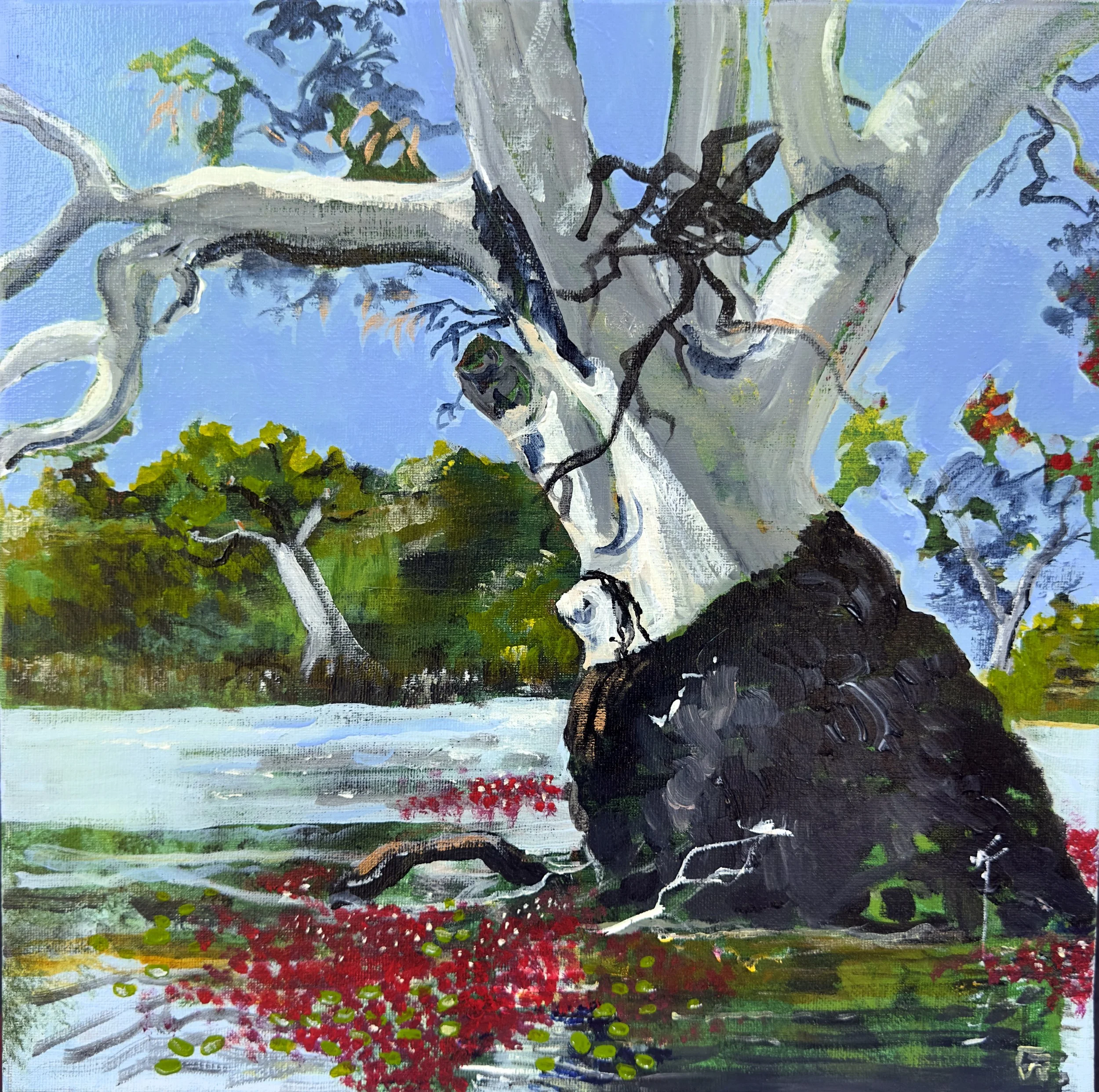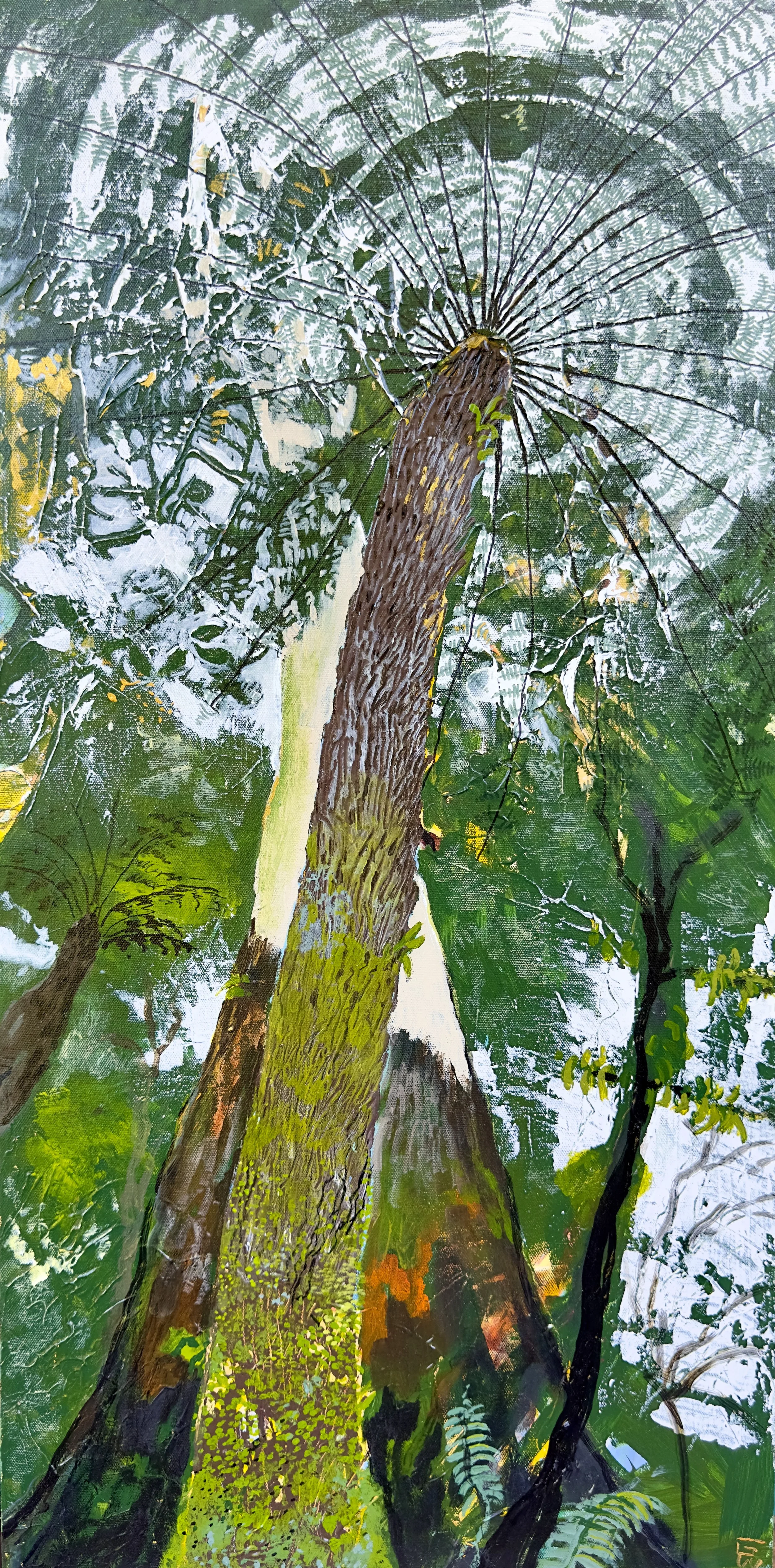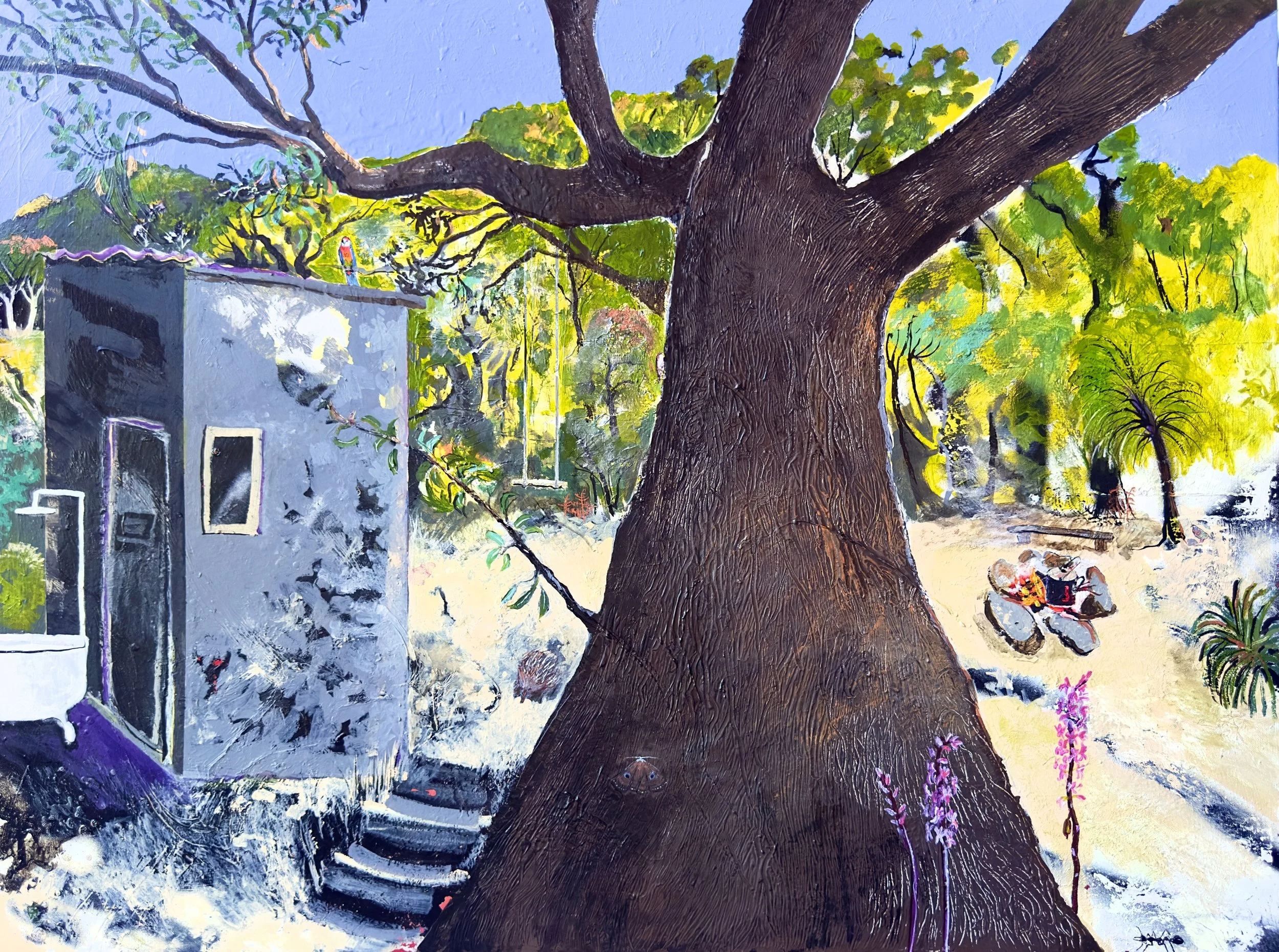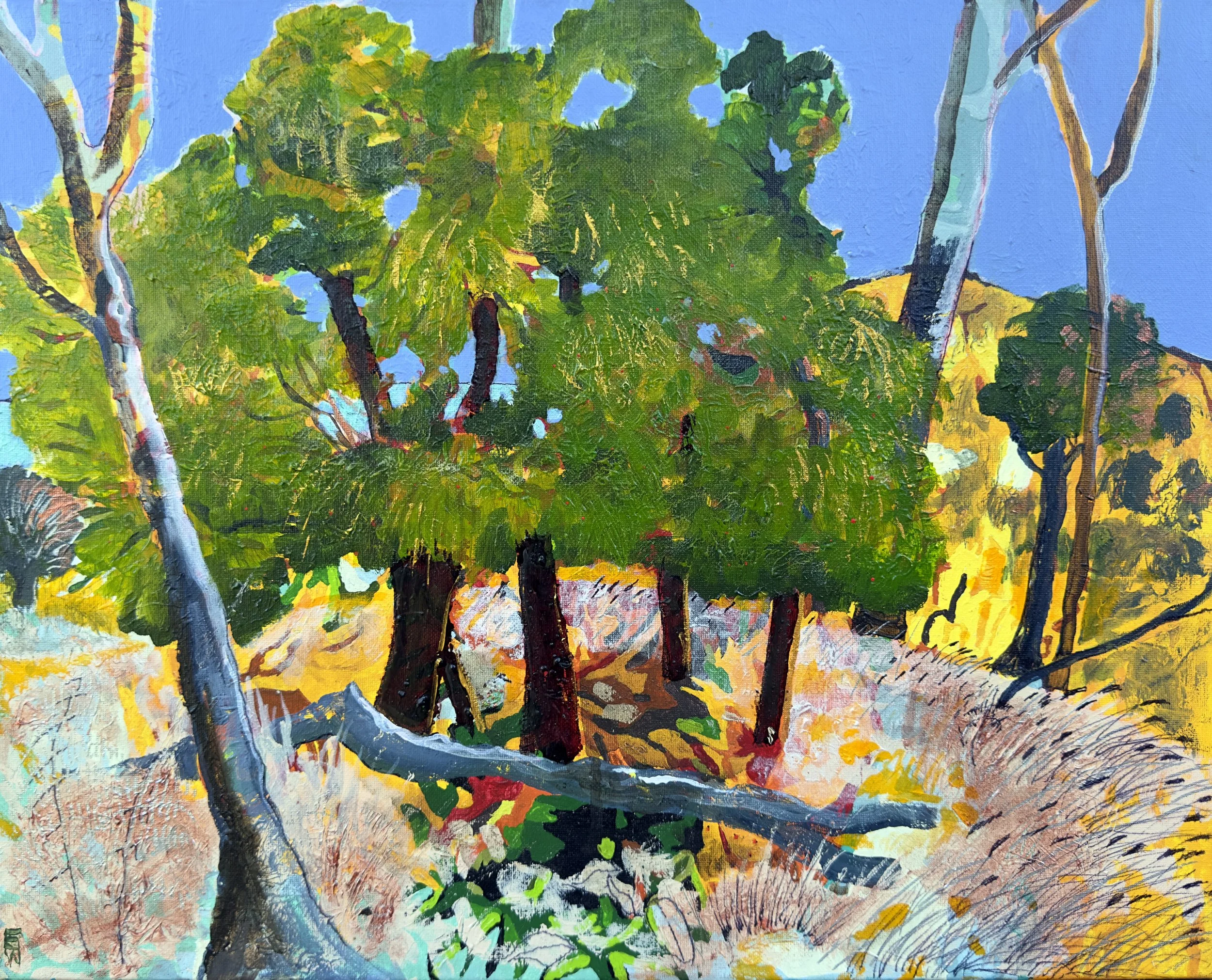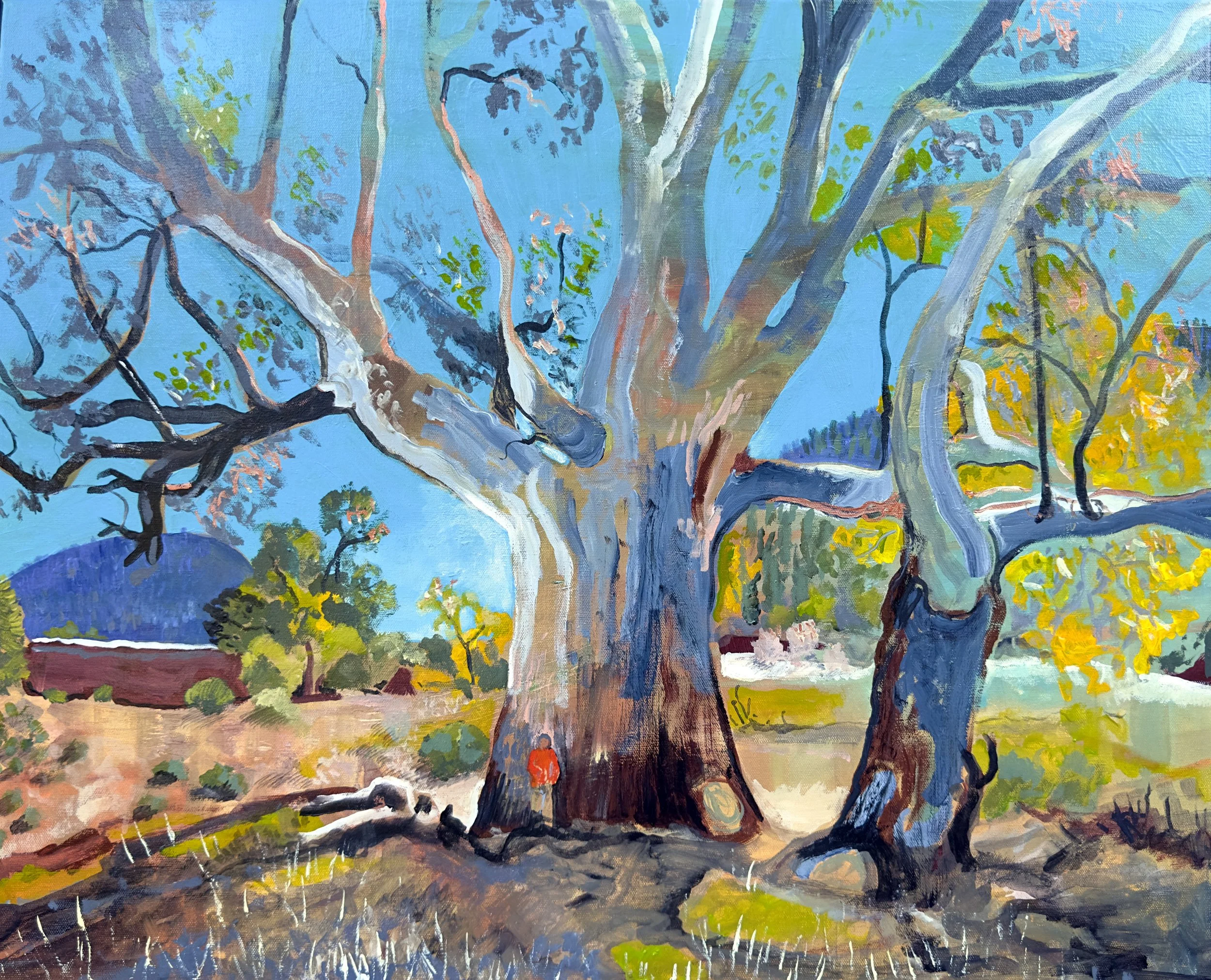Gidja Walker is a member of the Bush Workers Collective. We are honoured to showcase her recent series of work, Trees I’ve Known.
You can check out more about Gidja and see more of her work on her website here, https://www.gidjawalker.com.au/
Some images have been cropped for display, please click them to see the full sized version.
Callitris view of lake mungo
Paakantji, Mutthi Mutthi, and Ngiyampaa country
This Callitris tree stands at the edge of lake mungo looking over to the great wall of china – a feature created by the overgrazing of stock leading to erosion and exposure of the ancient remains of a woman and a man.
My first sight of this place was in my early teens, with my family including the dog, squashed in the holden heading for a fishing trip to an old camp on the darling river. My blind grandfather was directing which lead us coming on to dusk in the middle of nowhere.....with red kangaroos hopping in front of the car and my dad swearing. We finally made it out to the highway but I never forgot the sight of that desolate landscape.
Travelling there recently with new eyes and new understanding, it made more sense....why it looks that way.
And the long, long story from when it was a lush flourishing wetland with enough water and food to sustain a large community before climate change.
I sit by this old Callitris and wonder what its seen and what its ancestors saw.
Flooded Bael
Barapa Barapa country
River redgum (Eucalyptus camaldulensis) was first botanically described in 1832 at l’hortus camaldulensis di Napoli in Naples Italy.
What’s in a name.
They occur all over this country with a number of different subspecies.
To the Barapa Barapa they are known as Bael.
This tree in drier seasons has witnessed marriages and is part of the cultural landscape of the biggest inland island in so-called australia, Gawarra.
Here it is flooded, the water red with Azolla a water fern.
This tree taught me about water- not just water per se, but how high the water gets; what season it floods and how often; how long the water takes to drain/evaporate; how dry it gets and for how long....and whether the water is clean. This is one of the few areas along Mirri/Mile (Murray River) that is allowed relatively natural flows and that is reflected in its biodiversity.
The night herons watch from their roost in a distant tree.
Home range of the powerful owl
Bunurong country
This old tree taught me about strength in structure and how learning continues to grow and unfold.
Despite being hollow and the heart wood gone long ago the sap wood sustains it .
The inside is black with charcoal – potentially the eels from the creek were smoked here.
It’s hollow now a roost or nesting site for powerful owls .
They need big hollows in very old trees.
I had always thought this was a forest Manna Gum but looking at it now the leaves aren’t quite right.
There is always something new to see and learn from.
In dappled light of the treefern canopy
Gadabanud country
Wet Forest is aged by the understory.
The tree-ferns, Musk Daisy-bush and Austral Mulberry are often much older than the Mountain Ash canopy.
This Rough Treefern lives in a prehistoric forest festooned with mosses and epiphytic ferns, behind Kennett River.
At night the forest comes alive with glow worms.
Iron barks amongst the granite
Dja Dja Wurrung country
This place Guruya has an elemental stone/metal feel......a hardness.
It is reflected in the trees growing amongst these rocks.
Even the Ironbarks botanical name
Eucalyptus sideroxylon.
sider = iron xylon = wood
And the granite rocks.
Formed millions of years ago from molten magma, kilometres under the ground.
Taking hundreds of years to cool and crystallise.
Then all that ground above it washed and blown away.
To expose the rocks we now see.
To create niches for these Ironbarks and Lightwoods to nestle amongst.
On the weeping grass lawn.
Messmate at the Shack
Bunurong country
I used to go to the shack to sleep and dream. Embraced by the old messmate with its roots below and the canopy above I felt safe......connected.
On the night of a thousand moths my son was born there at dawn.
My daughter and step-son delighted in jumping off the roof on the swing but were less keen on the outside pit dunny.
The bath was outside too and heated with an electric element, the door was always open and the billy was always on. At night a myriad of interesting insects would flutter round the lights.
In the late summer season the Hyacinth orchids would burst out of the bull ant nest at the base of the old tree; White-throated Treecreepers climbed its trunk while the noisy Rosellas dropped Messmate seed and leaf gall remains on the tin roof. A Grey Shrike-thrush called while the echidna nosed around.
It still stands, over 30 years older but the same familiar shape and feel.
Mimosa Rocks Bangalay
Yuin country
These twisted trees at mimosa rocks on the Yuin coastline are some of my favourite trees, the colour of their bark...their twisted forms. I lie on them and look out at the sea.
On Bunurong country where they have been planted, they hybridise with our local Manna gums, a significant tree for the Bunurong. The lerps on their leaves also encourage the noisy miner to move in and take up new territory, which impacts on local birds. These birds are extremely aggressive even attacking large birds like ravens and ibis.
On Yuin country it’s my favourite tree.
On Bunurong country I work to have it removed.
Same tree different place.
Morning view of Wonga mar through the Bulath
Bunurong country
These Bulath (native cherry) trees represent the children to the Bunurong. They rely on the parent trees around them for sustenance...their roots entwined.
Each grove is one individual, the groves forming lines across the face of Wonga mar. These groves act as a fire break in the landscape, between the smooth barked less fire-adapted forest Manna-gums and the thick-barked stringy-barks, remaining green for a week after fire.
Bronze-winged Pidgeons are regularly seen scratching around underneath them looking for the red fruits with their seeds attached.
Ocean meets cliff
Bunurong country
Old Beard-heath.
Succumbing to the sea.
Beside one that succumbed before.
It’s wood replaced by stone.
Covered by sand.
To be revealed at a future time.
Old Wirra
Adnyamathanha country
When I travel to other places I like to find the old trees.
Remnants of nature.
Through them I feel better connected to place.
In Denmark we went to visit the Valdemar tree.
A big old oak tree.
While standing under it my thoughts went back to this ancient Wirra on Adnyamathanha country.
To the Adnyamathanha people this would be an important tree....they would have relationship with it.
You can’t but feel its age and be overwhelmed by its size.
Rays of light & the eagles flight
Bunurong country
Grass trees taught me about fire.
Right fire ......wrong fire.
There are many different grass trees on different country.
Those in the Ngarkat mallee have survived repeated lightning strikes.
They are coarse and tough.
Their trunk buried in the sand.
The small grass tree from grassy woodlands also grows in the ground as an adaptation to grassland fire.
These grasstrees from Boniong on Bunurong land are survivors of a “controlled burn” which covered 10’s of hectares.
The stunning mass flowering from the survivors is a stress response ....but gives the wrong impression.
Many grasstrees die under this type of fire, and some of those that do survive will collapse years later from fire scars weakening the trunk.
Hopefully this method of burning will become a thing of the past as Bunurong become more involved in land and fire management.
What price a view
Bunurong country
Moonah is a forever tree.
It’s twisted form clinging to the dunes to avoid flying off into the sky in the swirling wind.
This ancient tree at Duwurrnandju (Cape Schanck) sits at the edge of the old fault line where the basalt and limestone merge.
It’s being destroyed by people searching for a view.
Signs and barriers removed.
Its branches cut to protect a path.
I feel its pain....I feel its decline.
The shells and charcoal underneath its sprawling branches tell the story of many generations of Bunurong sharing its space with respect and caring.
With respect and care this tree could revive and continue.
Time will tell.
